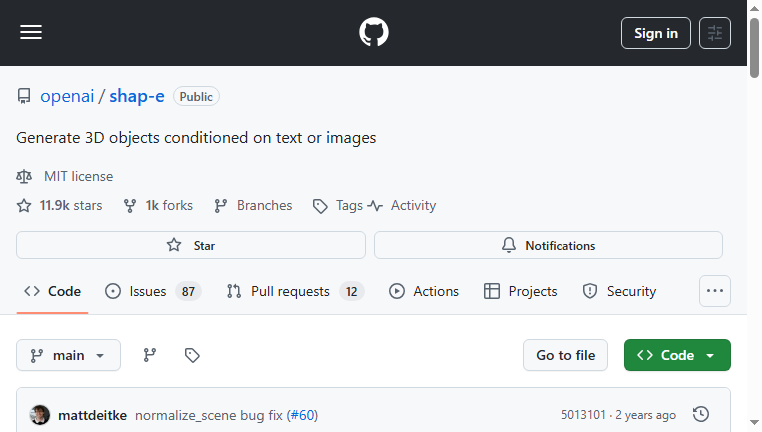Shap-e
Shap-e is a dynamic tool designed to create 3D objects from text or images, making it an essential resource for designers, artists, and architects. By simplifying the process of 3D modeling, Shap-e allows for efficient creation and exploration of unique concepts. This flexibility encourages innovati... Read More
More Detail
Shap-e is a dynamic tool designed to create 3D objects from text or images, making it an essential resource for designers, artists, and architects. By simplifying the process of 3D modeling, Shap-e allows for efficient creation and exploration of unique concepts. This flexibility encourages innovative design solutions while catering to diverse project requirements.
What you can do with Shap-e and why it’s useful
◆Main Functions and Features
・Text-to-3D Conversion
Shap-e translates text inputs into fully realized 3D objects. This feature allows users to describe their visions and see them materialize in three dimensions, bridging the gap between ideas and tangible designs.
・Image Integration
The tool can also process images to create detailed models that reflect the source visuals accurately. This versatility supports users looking to enhance their concepts with realistic elements derived from existing visual content.
・Customizable Parameters
Users have the ability to fine-tune various modeling parameters, enabling a personalized approach to 3D object creation. This function empowers users to adapt the output to their specific design needs and preferences.
・Rapid Prototyping
Shap-e facilitates quick prototyping, allowing users to create multiple iterations of a design rapidly. This flexibility enables faster exploration of ideas and reduces the time taken to reach a final design.
・Export Formats
3D objects generated through Shap-e can be exported in various standard formats for use in different applications. This feature ensures seamless integration into existing workflows, regardless of the software being utilized.
・User-Friendly Interface
The tool features an intuitive, user-friendly interface that simplifies the modeling process. With easy navigation and clear instructions, users can swiftly adapt and innovate, regardless of prior experience.
◆Use Cases and Applications
・Product Design Studies
Designers can employ Shap-e to generate prototypes for new products, enabling rapid visualization of concepts. This capability aids in refining ideas and gathering feedback before finalizing designs.
・Creative Concept Development
Artists can utilize the tool to experiment with new forms and structures based on text descriptions, supporting creative processes and pushing the boundaries of traditional design.
・Architectural Modeling
Architects can create preliminary models of buildings or structures based on descriptive text or reference images, accelerating the visualization process for their concepts. This effectiveness aids in stakeholder presentations and design iterations.
・Educational Applications
Shap-e can be utilized in academic settings for teaching design principles and 3D modeling skills. This hands-on approach enhances learning by allowing students to experiment and visualize their ideas in real-time.
・Game Asset Generation
Game developers can benefit from Shap-e by generating assets from descriptive prompts or images, streamlining the process of populating 3D environments effectively and efficiently.
Shap-e :Q&A
Who can use Shap-e?
Ideal for 3D artists, CG designers, game developers, architects, and product designers working with 3D modeling.
What are the main use cases for Shap-e?
Used for character modeling, architectural visualization, product design, game asset creation, and virtual environment construction.
Is Shap-e free or paid?
Some tools offer basic features for free, but high-resolution output and commercial use may require a paid plan.
Copyright © 2025 AI Ranking. All Right Reserved

